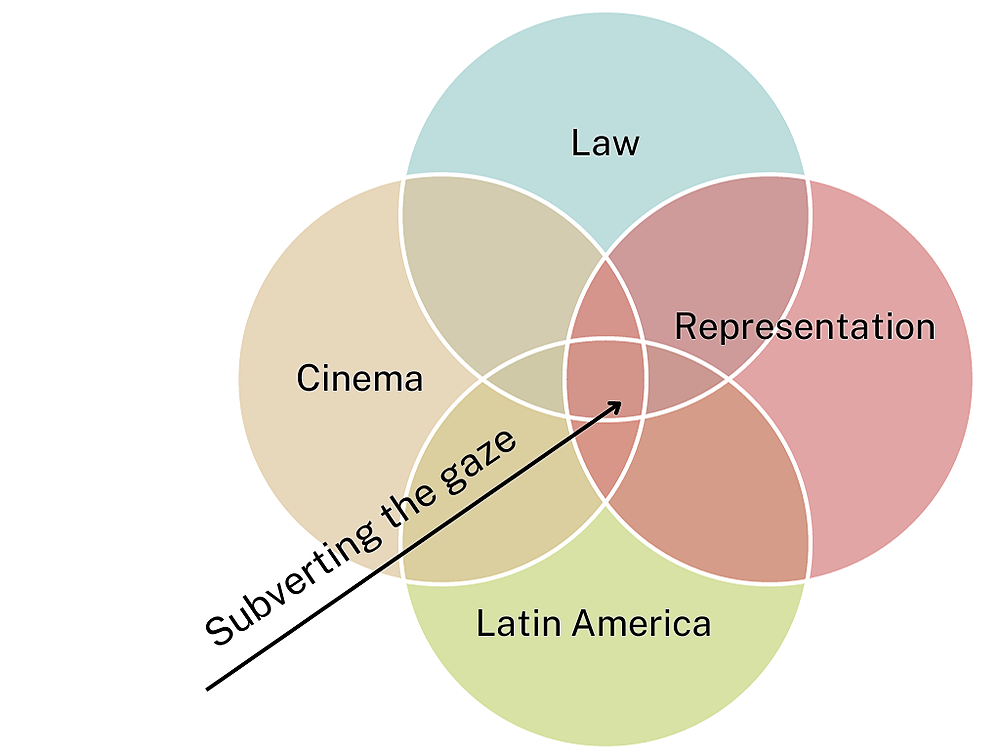Subverting the Gaze: Law & Representation in Cinema from Latin America
Event description
This event is about legality and resistance; global culture and local knowledge; film-making as ways of doing and undoing law. It features two presentations and a panel discussion presenting exciting new work about representations of law in contemporary cinema from Latin America.
Charlotte Gleghorn (University of Edinburgh) considers how recent First Nations film-making articulates challenging claims about the nature and experience of law. Indeed, films such as La raíz de la Resistencia (2012), she argues, collapse the boundary drawn between law and culture, not just representing a way of talking about law, but embodying and performing it.
Luis Gomez Romero (Legal Intersections Research Centre, University of Wollongong) argues that representations of the ‘narcos’ in US popular culture have profound effects on the way that law and violence are understood by US and Mexican governments in the waging of the so-called ‘drug war’. But powerful counternarratives grounded in local knowledges – such as the one developed in the recent Mexican film Ya no estoy aquí (2019) – prove that, from a cultural legal studies perspective, myth is not destiny.

Indigenous Cinematics: The Legal Lives of Indigenous Filmmaking in Latin America
12.00PM TO 1.00PM
In Indigenous film cultures across Abiayala/Latin America, the connection with Law is (at least) threefold: cinema portrays legal doxa, notably concerning territoriality and colonial claims to land and water; films – including the vast ethnographic archive and new, original works – are used to support particular legal cases; and productions index plural epistemological claims that are not easily subsumed in or accommodated by western legal ideas. First Nations’ legal systems are mobilised through language, song, dance, storytelling, weaving, painting, and ritual, among other cultural expressions, all of which are conjugated through cinema, inflecting the politics of attribution, authorship and authority across the region. Consider the first fiction feature produced in Wayuunaiki, the language of the binational Wayúu people, whose homelands traverse the Colombo-Venezuelan border. La raíz de la resistencia (The Roots of Resistance) (Jorge Montiel/Maikiraalasalii Collective, 2012) crafts a complex narrative architecture designed to collapse the boundary drawn between law and culture. In this way, the film is a compelling example of how cinematic story embodies the Wayúu way of doing law.
Across the Border: Jurisprudential Variations on the Cinematic Myth of the Big, Bad Narco
1.00PM TO 2.00PM
This talk addresses the relevance of stories (generally) and myths (specifically) in shaping law and our conceptions of justice, as evidenced through two films – Sicario (2015) and Ya no estoy aquí (2019) – whose narratives are ingrained upon drug war discourses and practices. Storytelling is central to legal discourses, which are (and have always been) firmly rooted in myth. Narco myths actually aggravate the conflict and impair its peaceful solution by framing law enforcement tasks on the prohibition of illegal drugs as a series of timeless battles between good (embodied in civil society and its governmental protectors in Mexico and the U.S.) and an irreducible evil (personified in the infamous traffickers and their allegedly all-powerful cartels). Hollywood narco narratives such as Sicario have ramped up not the power of traffickers, but the violence exercised by the Mexican and American states alike to eradicate the alleged existential threat drug trafficking embodies. Powerful counter-narratives grounded in local knowledges – such as the one developed in Ya no estoy aquí –, however, prove that, from a cultural legal studies perspective, myth is not destiny.
Tickets for good, not greed Humanitix dedicates 100% of profits from booking fees to charity
